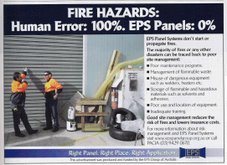
Case Study: Major fire in Australian food production facility
The following extract from a NSW Fire Brigade Union report on the Tip Top Bakery Fire in Fairfield, NSW on 2nd June, 2002 acknowledges the fire susceptibility of polystyrene foam insulation panels:
“Polystyrene foam is thermoplastic, that is, it softens when heated. Thermoplastic materials tend to melt and shrink away from heat long before ignition. This melting causes voids that reduce the structural strength of the panels. As the panels buckle, the joints tend to open introducing flame and air into the core. This results in internal flame spread between the panels and throughout the structure and there is likely to be a rapid loss of structural strength and subsequent collapse of walls and ceilings. Polyurethane and polyisocyanurate foams are both thermosetting materials, which means that
they do not melt, flow or drip when exposed to fire. Rather, they form a strong carbonaceous char that helps to protect the foam core and prevent flame spread within the panels themselves. It would appear that the insulated sandwich panels utilised in the construction of the Tip Top factory were constructed with polystyrene insulation. Construction using polystyrene insulated sandwich panels presents several major difficulties for fire fighting:
• The loss of adequate structural integrity and subsequent likelihood of significant building collapse;
• The combustibility of the insulation material adds substantially to the fire load and results in the production of large amounts of heat, smoke and toxic products;
• Fire spread can be hidden within the panels, and
• This fire spread can be rapid, leading to conditions that favour flashover.
There have been incidents in other countries where firefighters have lost their lives whilst engaged in offensive firefighting tactics in structures constructed with insulated sandwich panels. Firefighters need to be aware of the inherent dangers of this type of lightweight construction. Incident commanders must be aware that firefighting in these conditions can be extremely hazardous with early collapse, high fire load and massive smoke production being major factors affecting firefighter safety.”


